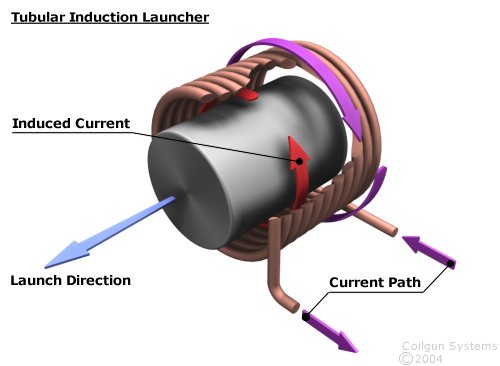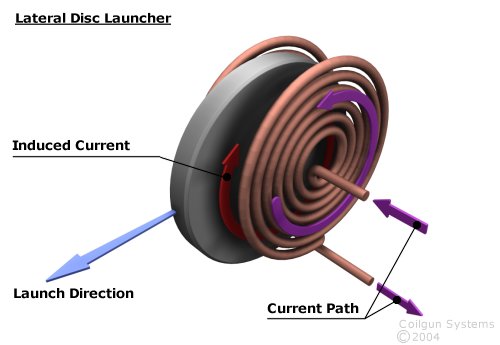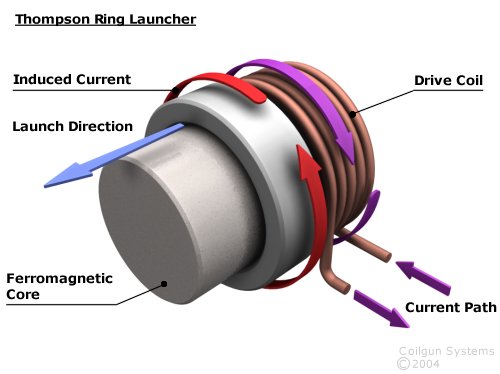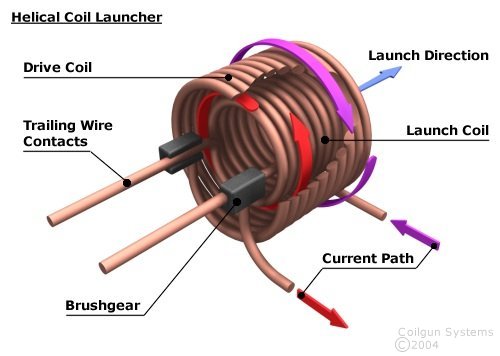
|
Coilgun Basics (3 of 3) The Induction Coilgun The classical tubular induction coilgun is essentially identical to the simple reluctance coilgun in terms of its general construction. The difference is that the projectile is repelled out of the coil through the action of eddy currents induced in the projectile. The projectile must be non-ferromagnetic (e.g. copper or aluminium) and the starting position needs to be slightly off-centre in the coil otherwise it wont experience a net force when the coil is fired. The impulse experienced by the projectile depends on mutual inductance and magnetic diffusion processes, which must be taken into account to effect a good design. When a multistage launcher is designed, the individual drive coils can be made short compared to the projectile length, allowing a smoother acceleration profile. It should also be noted that the projectile need not be a solid conductor - a projectile comprising a coil shorted on itself can also be used and offers efficiency advantages[1]. The projectile can also be tubular where it rides a cavity formed by the drive coils and an inner, rifled mandrel. The mandrel provides support to the projectile against the radial component of the driving force, while also imparting spin. This particular configuration has been termed the Theta Gun[2].
The Reconnection Coilgun The reconnection coilgun (also known as the plate or disc launcher[3] ) consists of two coils stationed either side of the projectile. When a current is pulsed into the coils eddy currents form in the projectile and the interaction of the coil current and eddy currents propels the projectile. As the projectile leaves the coils the flux lines from the coils 'reconnect', hence the name [4,5]. A multi-stage cylindrical induction coilgun can also be referred to as a reconnection coilgun[6].
The 'Thompson' Coilgun Named after Elihu Thomson's jumping ring device, this is another style of induction coilgun and it works on the same principle as the classical induction coilgun. Again, the projectile is made from a non-ferromagnetic material like copper or aluminium. The diagram below shows one possible design for a single stage Thompson coilgun.
When the coil is fired the ferromagnetic core becomes magnetised, and as the magnetic flux increases in magnitude it causes a circumferential eddy current in the ring projectile. This induced current is repelled by the coil current and the projectile shoots off the core. The faster the flux is increased, the greater is the induced current and the resulting force on the projectile. For best results the core should be constructed from either laminations, bundled rods, or powdered material. This is necessary to minimise eddy currents in the core and therefore permit rapid flux swings. Generally speaking, in order to generated a sufficiently rapid increase in flux it is usually necessary to use potentials of several hundred volts or more. Due to the risk of electrocution from a high voltage capacitor these types of coilgun aren't suitable for the beginner.
The Helical Coil Launcher In this type of launcher[7] there are two coils; the drive coil (stator) and the launch coil (armature). The armature coil is connected electrically in series with the stator coil via brush gear that contacts the armature's trailing arms. The projectile is orientated such that the currents in the stator and armature travel in opposite directions, producing a repulsive force similar to that in the tubular induction launcher. The difference in this case is that the duration of the repulsion isn't limited to magnetic diffusion timescales.
It is possible to construct a helical coil launcher in which the armature/projectile rides on the outside of an elongated stator[8]. Rails are placed either side of the projectile and brushes channel current into the stator and projectile. The brushgear is arranged such that there is a section of energised stator immediately behind the armature regardless of the position of the armature on the stator.
The SPEAR coilgun This coilgun topology[9] employs passive commutation of the drive coils eliminating the need for active sensing. The armature is charged with an initial current that persists during the launch (i.e. the L/R time constant of the current decay is longer than the launch time). At the start of the launch the drive coils are fired and, as the projectile is drawn into the coils, each successive coil has its current driven to zero. The SCR switches that commutate current to the drive coils automatically turn off when the current goes through zero so no 'suckback', or braking force, is produced.
[1] J. A. Andrews and J. R. Devine, "Armature Design for Coaxial Induction Launchers", IEEE Transactions on Magnetics, VOL. 27, NO. 1, January 1991. [2] T. J. Burgess, E. C. Cnare, W. L. Oberkampf, S. G. Beard, and M. Cowan, "The Electromagnetic Theta Gun and Tubular Projectiles", IEEE Transactions on Magnetics, VOL. MAG-18, NO. 1, January 1982. [3] Paul R. Berning, Charles R. Hummer, and Clinton E. Hollandsworth, "A Coilgun-Based Plate Launch System", IEEE Transactions on Magnetics, VOL. 35, NO. 1, January 1999 [4] M. Cowan et al, "The Reconnection Gun", IEEE Transactions on Magnetics, VOL. MAG 22, NO. 6, November 1986. [5] M. Cowan, M. M. Widner, E. C. Cnare, B. W. Duggin, R. J. Kaye, and J. R. Freeman, "Exploratory Development of the Reconnection Launcher 1986-1990", IEEE Transactions on Magnetics, VOL. 27, NO. 1, January 1991 [6] Ronald J. kaye, et al, "Design and Performance of a Multi-Stage Cylindrical Reconnection Launcher", IEEE Transactions on Magnetics, VOL. 27, NO. 1, January 1991. [7] Thomas G. Engel, Dwayne Surls, and William C. Nunnally, "Prediction and Verification of Electromagnetic Forces in Helical Coil Launchers", IEEE Transactions on Magnetics, VOL. 39, NO. 1, January 2003. [8] T. G. Engel and W. C. Nunnally, "Development of a Small-Bore, High-Efficiency, Helical Electromagnetic Launcher", 14th IEEE International Pulsed Power Conference, June 2003, Digest of Technical Papers, pp 1099-1102. [9]
D. A. Bresie, J. L. Bacon, S. K. Ignram, K. S. Kennington, and D.
A. Weeks, "SPEAR Coilgun", IEEE Transactions on Magnetics,
VOL. 31, NO. 1, January 1995.
Last Modified: 18 July 2004 |





